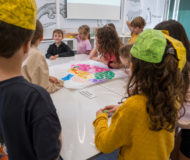

Mariona’s Adventure has arrived at the Barcelona Zoo with resounding success. All the scheduled workshops were fully booked, and participants enjoyed a day of scientific discovery in a unique setting where biomedical research and environmental education came together. Held on Saturday, September 27, this mission marked a major highlight of the project’s second edition, as for the first time it moved beyond Tibidabo Amusement Park to reach another emblematic space in the city. The goal is to expand outreach settings and grow the community that accompanies Mariona in her scientific adventures.
This mission was dedicated to the nervous system and was carried out in collaboration with both the science communication team of IR Sant Pau and the educational staff of the Barcelona Zoo. They joined forces to offer a complete and enriching experience. IR Sant Pau professionals prepared interactive workshops to explain in a simple and engaging way how the brain works and which structures are part of the nervous system. Through games such as science bingo and assembling a paper puzzle, children learned playfully about the functions that allow us to think, feel, and move. They also had the chance to see and handle 3D models of real brains—an experience that helped them better understand the size and characteristics of this organ, as well as the changes it undergoes when it becomes ill and its cells stop functioning. In addition, outdoors, a giant science memory game challenged the memory of both children and adults, turning learning into a collective and participatory game.
Meanwhile, the zoo’s educational team contributed their expertise to explain the role of the nervous system in the animal world. Through their outreach work and the zoo animals themselves, they showed how the senses are essential for survival and adaptation in each species. Families were able to closely observe examples demonstrating how night vision, smell, or enhanced hearing are key to communication and defense in animals in their natural habitats.
In this way, science and nature came together in a privileged setting, creating an immersive experience that allowed participants to discover the complexity and beauty of the nervous system in both humans and animals. The activity reinforced the idea that scientific research and environmental education share a common goal: fostering curiosity, knowledge, and respect for life.
You can find more information on the website:
https://www.santpau.cat/es/web/public/mariona-investigadora
The “Mariona Investigadora” project is an educational and outreach initiative developed by IR Sant Pau. Mariona is a character that symbolizes an eight-year-old girl passionate about science and medicine, whose purpose is to inspire children and young people to explore the world of scientific research. It is precisely at this age—around eight years old—that girls often begin to lose interest in science, due to persistent stereotypes and the lack of role models. This project seeks to address that gap.
Through a series of missions and challenges designed to be carried out at Tibidabo Amusement Park and at the Barcelona Zoo, Mariona encourages children to discover the secrets of the human body. They take part in scientific experiments and learn about the importance of adopting a healthy lifestyle.
The project also highlights the role of women in science, showcasing real examples of female researchers who share their professional and personal experiences to promote gender equality in this field.
IR Sant Pau continuously fosters dialogue with society, aligned with its RRI plan and with its objectives for Scientific Education and Public Engagement. As a CERCA center and as a Scientific Culture and Innovation Unit accredited by FECYT, it has a strong commitment to bringing research closer to society. As the only research institute in Catalonia with a transversal gender research program, IR Sant Pau serves as a spokesperson for the latest scientific advances. It underscores the importance of conducting research with a gender perspective and promoting the role of women in research and the future of science.